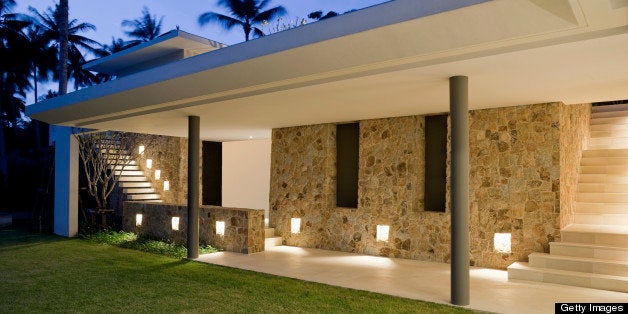
What do pillows and drapes have in common with grab bars and roll-in showers? In the world of interior design, plenty: They all help make a home more comfortable, even safer. As more people age at home, designers are starting to respond -- and, though they might not see themselves this way, they are becoming important contributors to public health and safety.
Decorating for public health and safety: Now that's the power of major demographic change.
In this first of two posts on the subject, we'll learn more about the why and who of design for aging at home. Because this boomer finds it easier to buy a car than a shower curtain, I turned to an expert for insight into designing lifelong homes.
Beth Hirshfeld is a former government advisor and lawyer-turned-home re-designer and Certified Aging in Place Specialist who runs the Toronto-based firm Thrive by Design. In this post, we talk about the role of good interior design and how home modifications are improving to please a design-sensitive generation.
How do you think Baby Boomers might change interior design as they get older?
Baby boomers seem to be changing the way that we think about everything. We can see the impact already! The home design industry is changing for the better to accommodate 'life cycle' needs. New research is resulting in innovative products that will help people to age more safely and comfortably at home without having to sacrifice beauty or style.
How do you explain the value of thoughtful interior design to people unfamiliar with its role?
Many people think of interior design as purely aesthetic, but good design also enables you to live well. It improves a home's functionality while also maintaining the home style that you've invested so much time and effort in creating, avoiding a sterile 'clinical' design.
Whether a home is updated to help someone move around a space more easily, to see more clearly during various activities, to hear better when guests come over, or to create an accessible space for a friend with health challenges, Aging In Place design will readjust a home to make it work for homeowners, rather than against them.
Decorating for age used to mean a comfy recliner. What do you think it means now?
Unfortunately, the general public has a negative impression of designing for aging adults, likely because products used to be quite clinical or simply unattractive in both look and feel. As a result, home modifications were often only undertaken to respond to an urgent need, such as after an injury.
Thankfully, our perception of aging is changing as we learn more about it. Studies show that older people are actually happier than younger people and have much to offer to a community. Embracing these insights and rejecting negativity about aging will likely help people to embrace age-related design as just a normal part of enjoying their home spaces to the fullest over time.
When people think about age-related modifications, their first thoughts may be of grab bars and roll-in showers. Dislike of grab bars and the expense and mess of renovation may put them off doing anything as a result. How do you get around this?
This is such a misconception! In fact, many improvements involve neither grab bars nor major renovation. We encourage people to start with a thorough home assessment to identify opportunities to make their space more functional and supportive. Anyone working with a Certified Aging In Place Specialist designer should get an assessment followed by a written report and suggested plan for implementation. A full range of large and small suggestion should go well beyond the traditional grab bars and ramps and have the potential to make all aspects of your life more functional.
What's more, decorating for age already uses techniques that are almost invisible to the untrained eye. Subtle changes to room composition and layout, in elements such as flooring, furniture placement, lighting and structure, all have a profound impact on functionality and safety - while still looking beautiful. In fact, even those stereotypical 'comfy recliners' have had a major make-over!
Can you give an example of a subtle but effective change?
Sure. If a person has always loved cooking but is starting to find it more difficult, a designer would work with that person to find solutions. For example, softer flooring is less stressful on the joints; a beautiful and sturdy stool will allow a cook to sit and chop more comfortably. Lighting, countertops, storage and other areas of the kitchen are all explored to determine the best ways to make the space more functional.
So as home modifications become more common, will we start to see grab bars and other signs of age or disability in a different light?
Safety and beauty don't have to be mutually exclusive. Home design for mature adults has evolved dramatically and many companies are starting to listen to consumer demand by delivering more innovative and attractive home-safety products. That shift, paired with many proven design strategies and techniques for aging, can really update a home while maintaining its comfortable feel.
Research has found that people are very poor at assessing risk. We worry about the wrong things. What have you seen?
Of the one in three seniors that fall every year, almost half fall at home. Many are rightly concerned that may occur in the bathroom, but other related areas get overlooked. For example, although almost half of individuals aged 65 or older get up during the night, usually to use the bathroom, research shows that many falls or injuries actually occur on the way there or back. Understanding and adjusting the nightly routine to make it as safe as possible could be very beneficial in reducing falls and injuries.
Overall, the key rooms and areas to assess for risk are the ones that people use most frequently.
Are there any "must have" items or modifications that you would include in every project?
Every project is different and what is right for one person may not be right for another. That being said, ensuring walking paths are well-lit and clear of tripping hazards is something that is beneficial for anyone!
Earlier on Huff/Post50:
